1994 CHEVROLET S10 wheel
[x] Cancel search: wheelPage 272 of 340
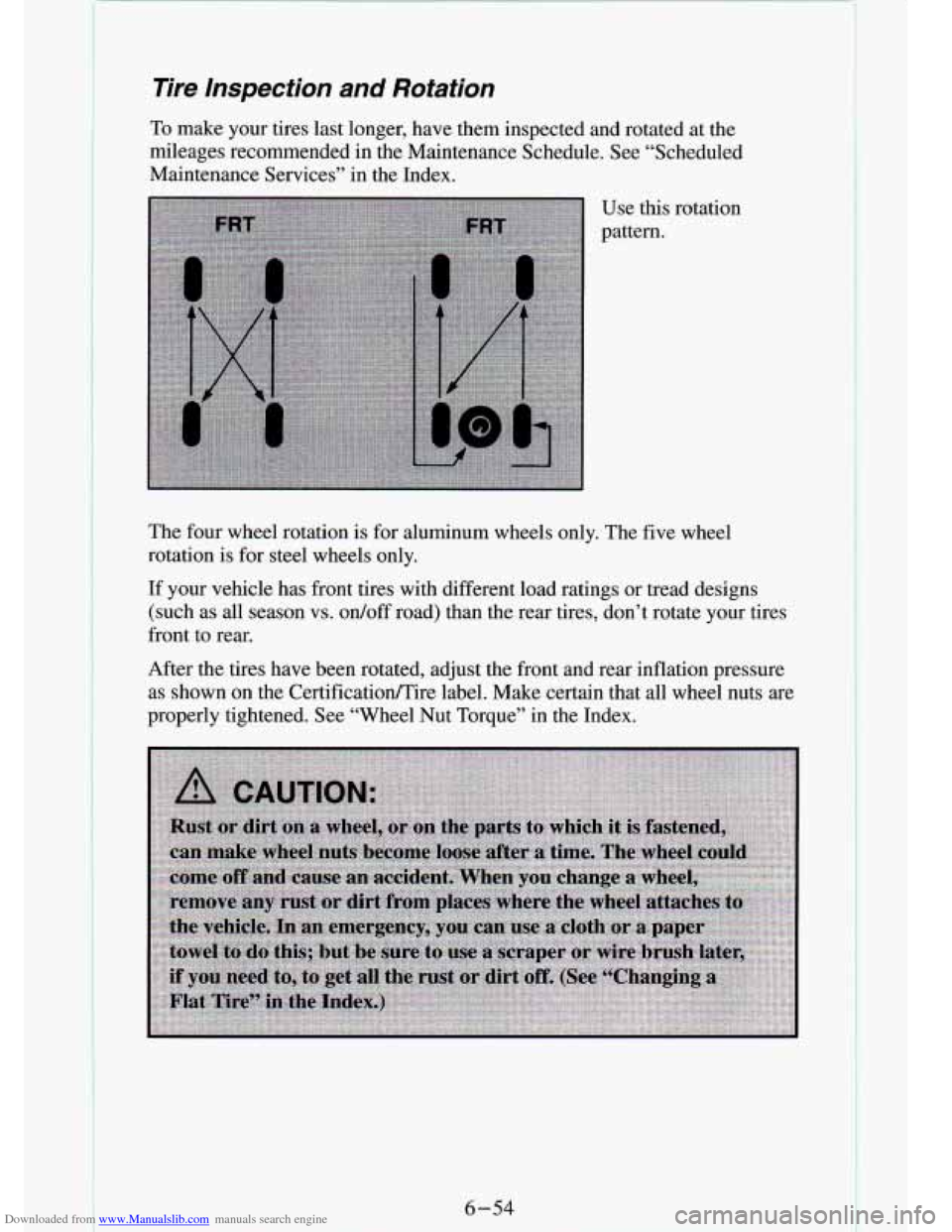
Downloaded from www.Manualslib.com manuals search engine lire Inspection and Rotation
To make your tires last longer, have them inspected and rotated at the
mileages recommended in the Maintenance Schedule. See “Schedul\
ed
Maintenance Services” in the Index.
Use this rotation
pattern.
The four wheel rotation is for aluminum wheels only. The five wheel
rotation is for steel wheels only.
If your vehicle has front tires with different load ratings or tr\
ead designs
(such as all season vs. ordoff road) than the rear tires, d\
on’t rotate your tires
front to rear.
After the tires have been rotated, adjust the front and rear inflation pressure
as shown on the CertificatiodTire label. Make certain that all wheel nuts are
properly tightened. See “Wheel Nut Torque” in the Index.
6-54
Page 275 of 340
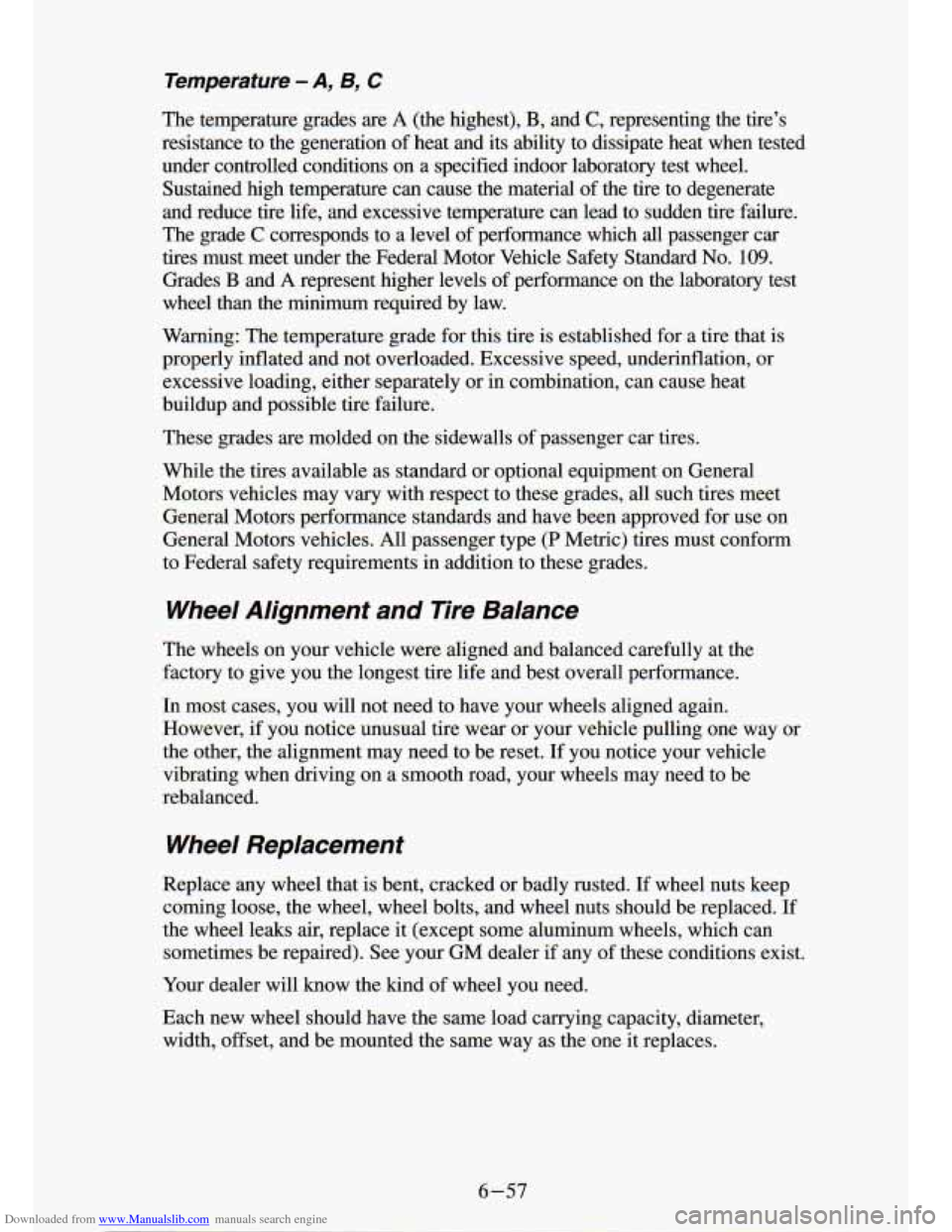
Downloaded from www.Manualslib.com manuals search engine Temperature -A, By C
The temperature grades are A (the highest), B, and C, representing the tire’s
resistance to the generation of heat and its ability
to dissipate heat when tested
under controlled conditions on a specified indoor laboratory tes\
t wheel.
Sustained high temperature can cause the material of the tire to degenerate
and reduce tire life, and excessive temperature can lead to su\
dden tire failure.
The grade
C corresponds to a level of performance which all passenger car
tires must meet under the Federal Motor Vehicle Safety Standard\
No. 109.
Grades B and A represent higher levels of performance on the laboratory test
wheel than the minimum required by law.
Warning: The temperature grade for
this tire is established for a tire that is
properly inflated and not overloaded. Excessive speed, underinfla\
tion, or
excessive loading, either separately or in combination, can cause heat
buildup and possible tire failure.
These grades are molded on
the sidewalls of passenger car tires.
While the tires available as standard or optional equipment on General
Motors vehicles may vary with respect to these grades, all such tires meet
General Motors performance standards and have been approved for use on
General Motors vehicles. All passenger type
(P Metric) tires must conform
to Federal safety requirements in addition to these grades.
Wheel Alignment and Tire Balance
The wheels on your vehicle were aligned and balanced carefully at the
factory to give you the longest tire life and best overall performance.
In most cases, you will not need to have your wheels aligned again.
However,
if you notice unusual tire wear or your vehicle pulling one way \
or
the other, the alignment may need to be reset. If you notice your vehicle
vibrating when driving
on a smooth road, your wheels may need to be
rebalanced.
Wheel Replacement
Replace any wheel that is bent, cracked or badly rusted. If wheel nuts keep
coming loose, the wheel, wheel bolts, and wheel nuts should be replaced.
If
the wheel leaks air, replace it (except some aluminum wheels, \
which can
sometimes be repaired). See your GM dealer if any of these conditions exist.
Your dealer will know the kind of wheel you need,
Each new wheel should have the same load carrying capacity, diameter,
width, offset, and be mounted the same way as the one it replaces.
6-57
Page 276 of 340
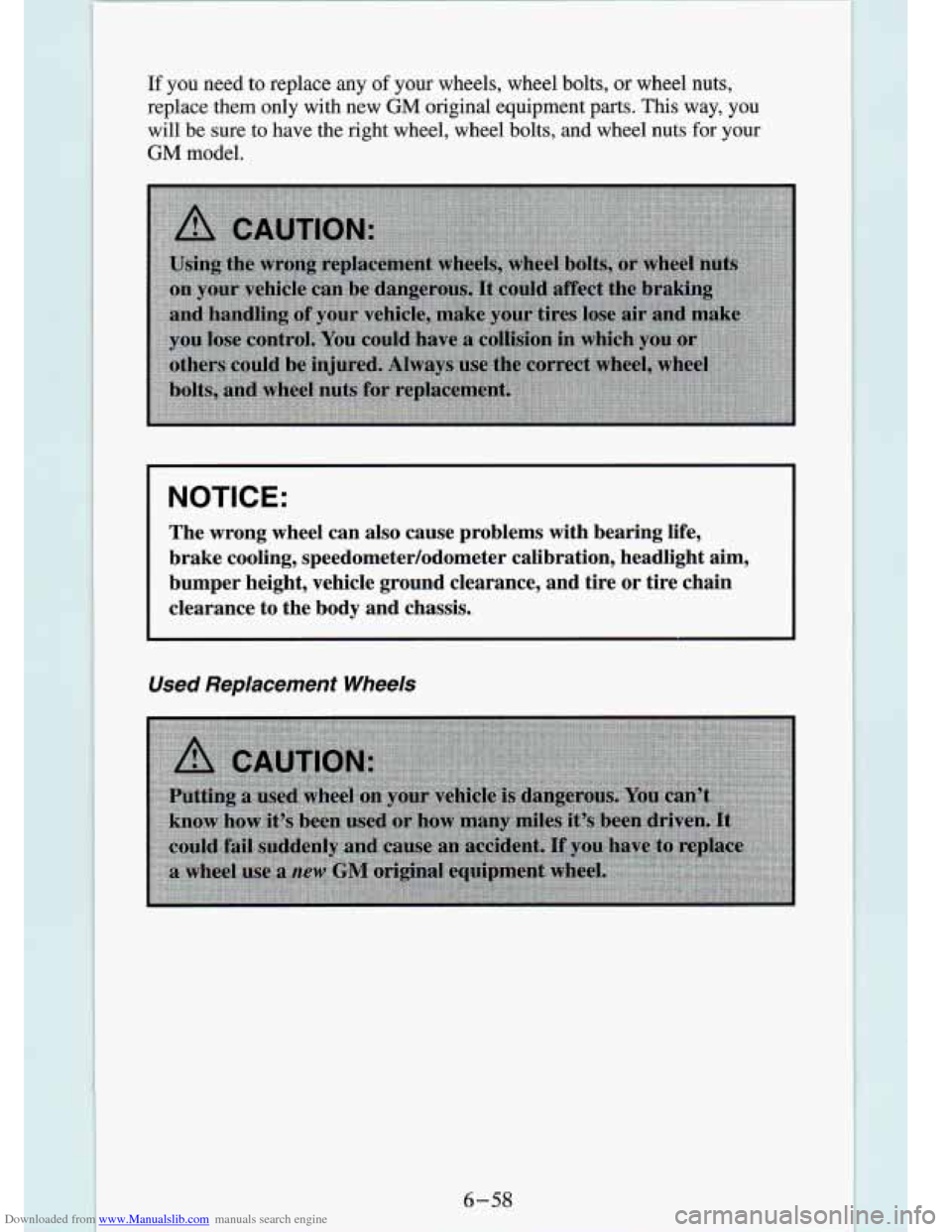
Downloaded from www.Manualslib.com manuals search engine If you need to replace any of your wheels, wheel bolts, or wheel nuts,
replace them only with new
GM original equipment parts. This way, you
will be sure to have the right wheel, wheel bolts, and wheel \
nuts for your
GM model.
NOTICE:
The wrong wheel can also cause problems with bearing life,
brake cooling, speedometer/odometer calibration, headlight aim,
bumper height, vehicle ground clearance, and tire or tire chain\
clearance to the body and chassis.
Used Replacement Wheels
6-58
Page 277 of 340
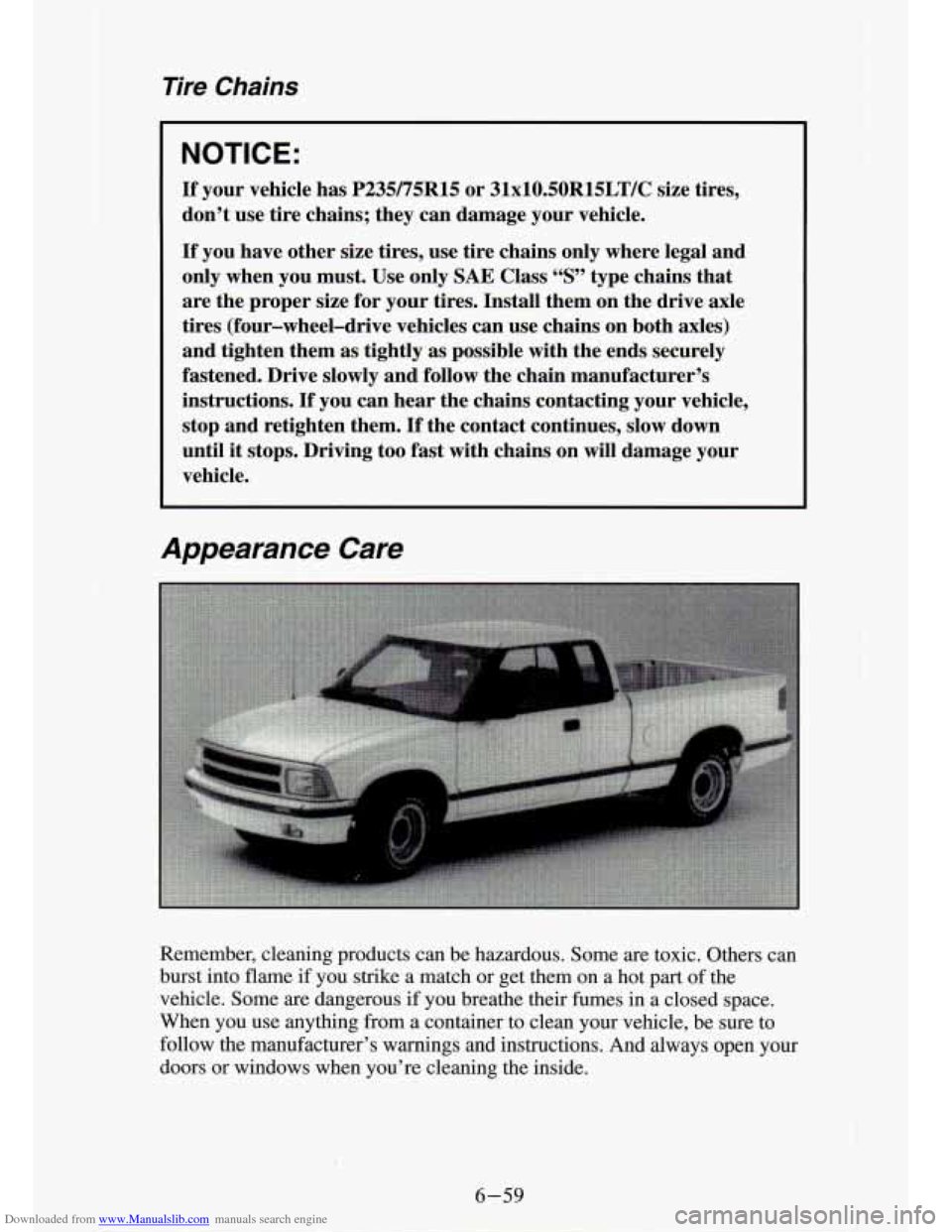
Downloaded from www.Manualslib.com manuals search engine Tire Chains
NOTICE:
If your vehicle has P235/75R15 or 31xlOSOR15LT/C size tires,
don’t use tire chains; they can damage your vehicle.
If you have other size tires, use tire chains only where legal and
only when you must. Use only SAE Class “S” type chains that
are the proper size for your tires. Install them on the drive axle
tires (four-wheel-drive vehicles can use chains on both axles)
and tighten them as tightly
as possible with the ends securely
fastened. Drive slowly and follow the chain manufacturer’s
instructions.
If you can hear the chains contacting your vehicle,
stop and retighten them.
If the contact continues, slow down
until
it stops. Driving too fast with chains on will damage your
vehicle.
Appearance Care
Remember, cleaning’ products can be hazardous. Some are toxic\
. Others can
burst into flame
if you strike a match or get them on a hot part of the
vehicle. Some are dangerous
if you breathe their fumes in a closed space.
When you use anything from
a container to clean your vehicle, be sure to
follow the manufacturer’s warnings and instructions. And always open your\
doors or windows when you’re cleaning the inside.
6-59
Page 283 of 340
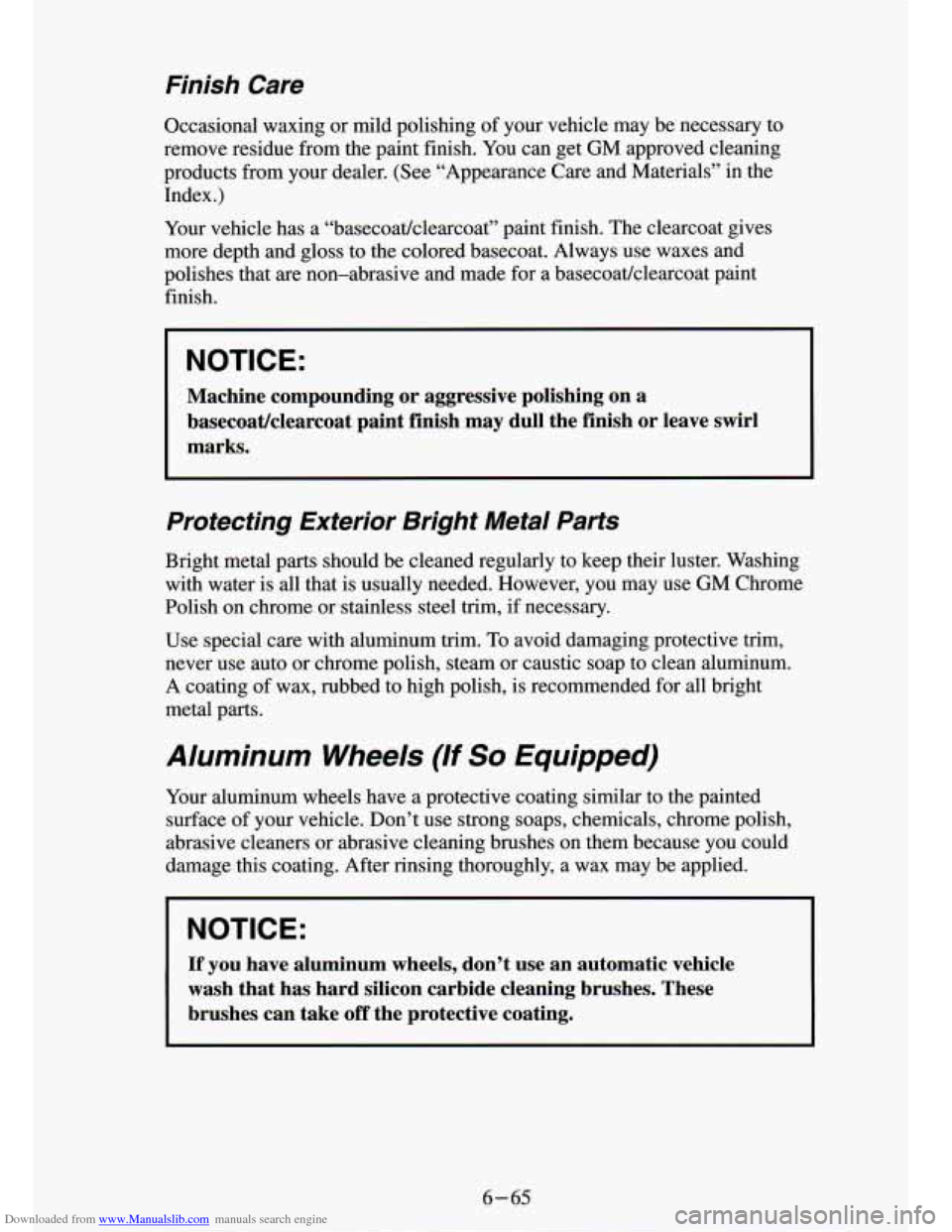
Downloaded from www.Manualslib.com manuals search engine Finish Care
Occasional waxing or mild polishing of your vehicle may be necessary to
remove residue from the paint finish. You can get GM approved cleaning
products from your dealer. (See “Appearance Care and Materials” in the
Index
.)
Your vehicle has a “basecoatlclearcoat” paint finish. The clearcoat gives
more depth and gloss to the colored basecoat. Always use waxes and
polishes that are non-abrasive and made
for a basecoatlclearcoat paint
finish.
NOTICE:
Machine compounding or aggressive polishing on a
basecoatdclearcoat paint finish may dull the finish or leave sw\
irl
marks.
Protecting Exterior Bright Metal Parts
Bright metal parts should be cleaned regularly to keep their luster. Washing
with water is all that
is usually needed. However, you may use GM Chrome
Polish on chrome or stainless steel
trim, if necessary.
Use special care with aluminum
trim. To avoid damaging protective trim,
never use auto or chrome polish, steam or caustic soap to clean aluminum.
A coating of wax, rubbed to high polish, is recommended for all bright
metal parts.
Aluminum Wheels (If So Equipped)
Your aluminum wheels have a protective coating similar to the painted
surface of your vehicle. Don’t
use strong soaps, chemicals, chrome polish,
abrasive cleaners or abrasive cleaning brushes
on them because you could
damage this coating. After rinsing thoroughly, a wax may be applied.
1 NOTICE:
If you have aluminum wheels, don’t use an automatic vehicle
wash that has hard silicon carbide cleaning brushes. These
brushes can take
off the protective coating.
6-65
Page 288 of 340
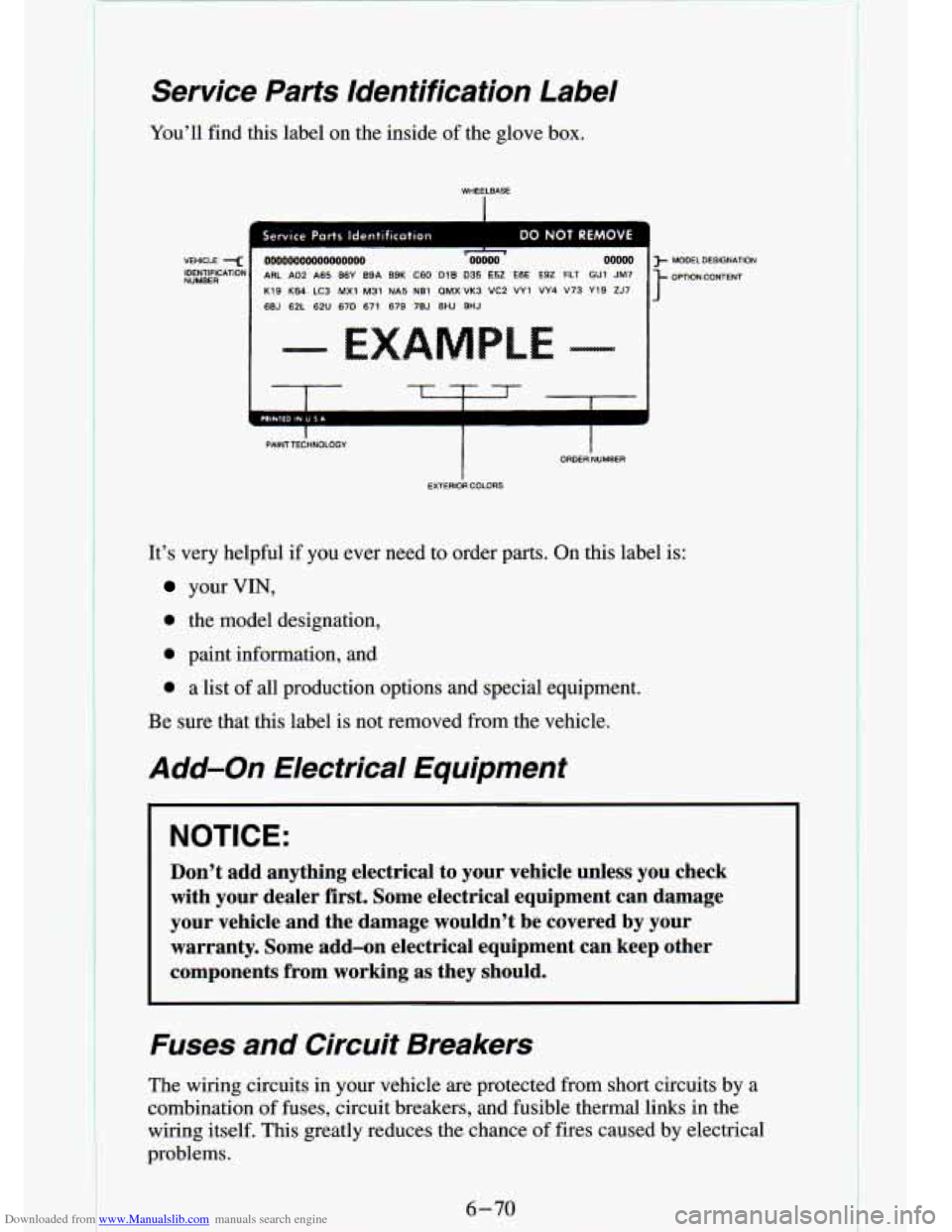
Downloaded from www.Manualslib.com manuals search engine - :
-.
Service Parts Identification Label
You’ll find this label on the inside of the glove box.
WHEELBASE
I
I
Service Parts ldentificotion DO NOT REMOVE I
VEHICLE < ~~0~0000000
NUMBER IDENTlFlCATlON ARL
A02 A65 B6Y BSA B9K C60 D1B 035 €52 E6E E92 FLT GUl JM7 OPTION CONTENT
7 00000 ooooo )- MODELDESIGNATION
K19 K64 LC3 MXl M31 NA5 NE1 QMXVK3 VC2 VY1 VY4 V73 Y19 ZJ7
6BJ 62L
62U 67D 671 679 7BJ 8HJ SHJ
I PAINTTECHNOLOGY I ORDER I NUMBER
EXTERIOR
COLORS
It’s very helpful if you ever need to order parts. On this label is:
your VIN,
0 the model designation,
0 paint information, and
0 a list of all production options and special equipment.
Be sure that this label is not removed from the vehicle.
Add-on Electrical Equipment
NOTICE:
Don’t add anything electrical to your vehicle unless you che\
ck
with your dealer first.
Some electrical equipment can damage
your vehicle and the damage wouldn’t be covered by your warranty. Some add-on electrical equipment can keep other
components from working as they should.
Fuses and Circuit Breakers
The wiring circuits in your vehicle are protected from short c\
ircuits by a
combination of fuses, circuit breakers, and fusible thermal links in the
wiring itself.
This greatly reduces the chance of fires caused by electrical
problems.
Page 291 of 340
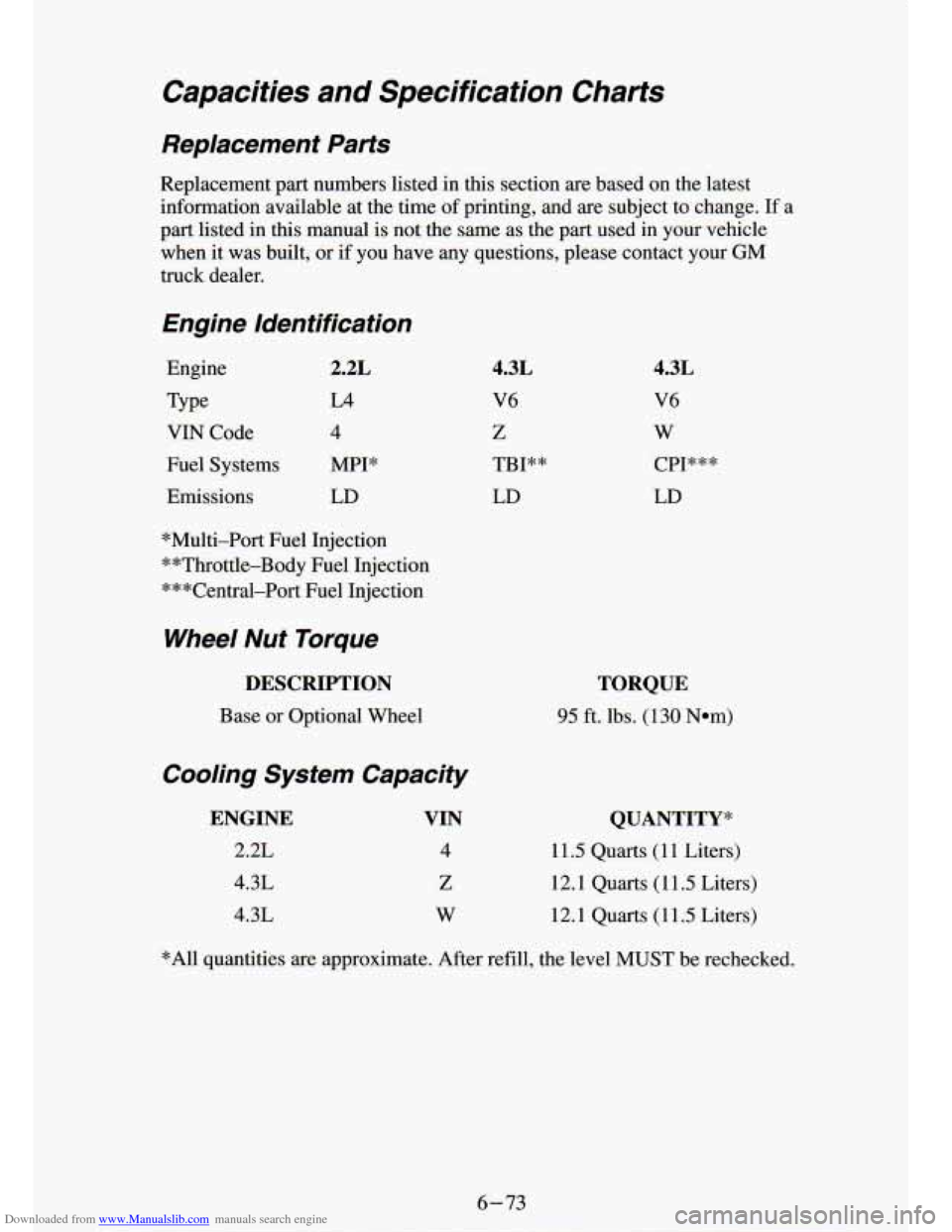
Downloaded from www.Manualslib.com manuals search engine Capacities and Specification Charts
Replacement Parts
Replacement part numbers listed in this section are based on the latest
information available at the time of printing,
and are subject to change. If a
part listed
in this manual is not the same as the part used in your vehicle
when it
was built, or if you have any questions, please contact your GM
truck dealer.
Engine Identification
Engine
Type
VZN Code
Fuel Systems
Emissions
2.2L
L4
4
MPI* LD
*Multi-Port Fuel Injection
**Throttle-Body Fuel Injection
***Central-Port Fuel Injection
Wheel Nut Torque
DESCRIPTION
Base or Optional Wheel
Cooling System Capacity
ENGINE VIN
2.2L 4 4.3L
Z
4.3L w
4.3L
V6
Z
TBI**
LD
4.3L
V6
W
CPI* * *
LD
TORQUE
35 ft. lbs. (130 Nom)
QUANTITY*
11.5 Quarts (1 1 Liters)
12.1 Quarts (11.5 Liters)
12.1 Quarts (11.5 Liters)
*All quantities are approximate. After refill, the level
MUST be rechecked.
6-73
Page 293 of 340
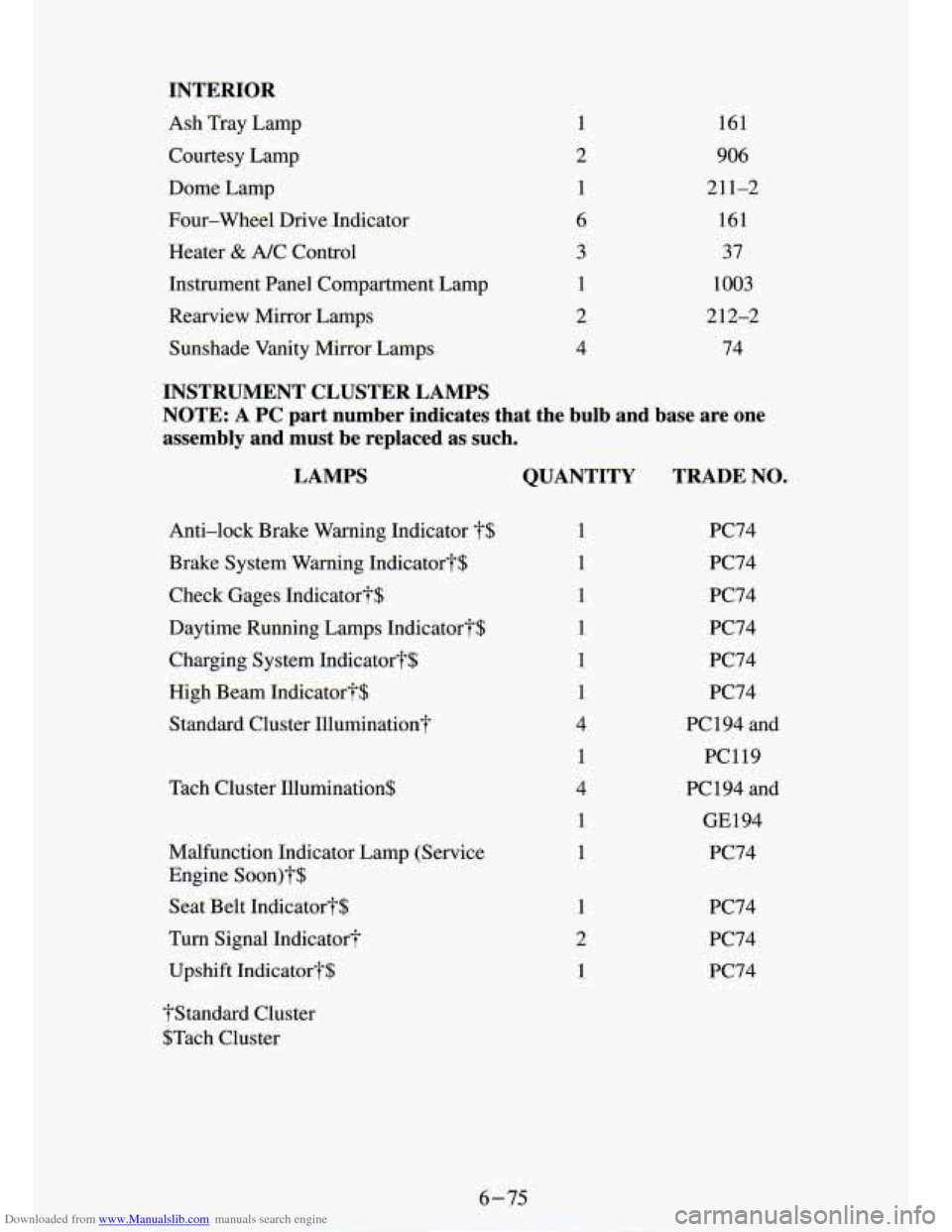
Downloaded from www.Manualslib.com manuals search engine INTERIOR
Ash Tray Lamp
Courtesy Lamp
Dome Lamp
Fol -Wheel Drive - lit, lr
Hearer & A/C Controi
Instrument Panel Compartment Lamp
Rearview Mirror Lamps Sunshade Vanity Mirror Lamps 1
2 1
4 161
906
211-2 161
37
1003
2 12-2
74
INSTRUMENT CLUSTER LAMPS NOTE:
A PC part number indicates that the bulb and base are one
assembly
and must be replaced as such.
LAMPS QUANTITY
TRADE NO.
Anti-lock Brake Warning Indicator ?$
Brake System Warning Indicator?$
Check Gages Indicator?$
Daytime Running Lamps Indicator?$
Charging System Indicator?$ High Beam Indicator?$
Standard Cluster Illumination?
Tach Cluster Illumination$
Malfunction Indicator Lamp (Service
Engine
Soon)?$
Seat Belt Indicator?$
Turn Signal Indicator?
Upshift Indicator?$
?Standard Cluster
$Tach Cluster 1
1
1
1
1
1
4
1
4
1
1
PC74
PC74
PC74
PC74
PC74
PC74
PC 194 and
PC119
PC194 and
GE 194
PC74
PC74
PC74
PC74